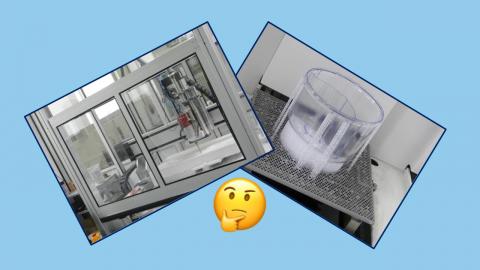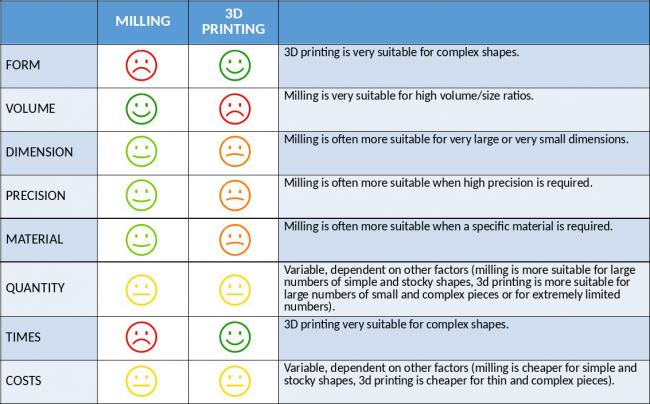CNC milling VS 3D printing
CNC milling VS 3D printing Nicola FeliceIn this guide we try to illustrate the characteristics, advantages and disadvantages, both from a technical and economic point of view, of the two solutions most used today to translate a project or an idea into reality.
Milling
In general terms, milling is a process in which, starting from a solid, which can have the shape of a block, plate, bar, material is removed by means of a cutting tool.
This general concept is translated into a very wide variety of machines, which differ in size, solidity, precision, operating principle. In particular, some machines operate by moving the tool in the direction of the cut, while the piece remains fixed, others move the piece, while the structure that carries the tool remains fixed. Furthermore, depending on the characteristics of the machine, these movements can be characterized by 3 or 4 or 5 degrees of freedom, thus determining the complexity of the geometries that can be created.
Milling is then often associated with turning which also operates by removing material using a cutting tool, but whose application is limited to the realization of axial-symmetrical pieces.
3D printing
3D printing is a decidedly more recent production solution, which began its development during the last decades of the 1900s and is now consolidated and entered into common use.
The operating principle is opposite to milling and consists in the addition of material which takes place layer by layer, based on the two-dimensional geometry obtained from the succession of sections of the 3D CAD model. The material can be found in both solid and liquid state, and in the form of dust; depending on the type of material, the technical solution adopted to produce the solid object gives rise to a wide variety of technologies and machines, such as sintering, stereolithography, filament extrusion, lamination, jet printing.
Factors to evaluate
Despite the huge variety of machinery and technological solutions available today in both milling and 3D printing, which makes it difficult to establish in general which solution is optimal for the specific problem, it is still possible to identify guidelines to better orientate in the choice process. Let's see together some parameters to keep in mind.
Form
The salient feature of all 3D printing solutions is that of proceeding layer by layer, thus overcoming many undercut problems related to the realization of complex geometries through a solid tool that must move on the piece or inside the piece. Complicated geometric shapes are therefore certainly achievable with greater ease through 3D printing.
Volume
Precisely because of the opposite principle of operation in terms of material subtraction or addition, it is clear that milling will be cheaper for very large pieces because they will have little material to remove (ie similar to solid blocks), while 3D printing will be more efficient for pieces of limited volume for the same size (ie similar to empty boxes).
Dimension
In both sectors there are machines capable of operating on very variable dimensions, therefore the size is not usually decisive in the choice. It should be borne in mind, however, that, when it comes to very large or very small dimensions, the great tradition of the milling sector is often able to offer more efficient solutions in these extreme areas of application.
Precision
In general, it can be said that high precision milling is certainly more precise than even very detailed 3D printing. This does not mean that a certain 3D printing machine cannot perform a piece guaranteeing repeatability and precision higher than a certain milling machine. It should also be borne in mind that in some processes characterized for example by undercuts, some geometries cannot be achieved by milling, and in these cases, the comparison is decidedly in favor of 3D printing. Furthermore, the minimum detail achievable by milling is given by the diameter of the tool that removes the chip, while in the case of 3D printing the limit is given by the diameter of the element that brings the material (which can be an extruder, a laser, the nozzle of a printer, etc.); it is therefore likely that in the case of milling the lower dimensional limits are more critical for negative details, while for 3D printing the positive details will be more critical.
Material
Today it is possible to mill practically any material of technical interest, while the materials available with 3D printing are more limited even if the availability increases constantly and has already covered almost all the most relevant materials in the plastic and metal sector. It is also essential to keep in mind the fact that the functional characteristics of a material are not determined only by its chemical composition, but also by its internal structure which is determined by the production technology. For example, the mechanical strength characteristics that can be expected from a lever made by milling a nylon block, are absolutely higher than those obtainable by filament extrusion of the same material and, usually the characteristics of the milled pieces are isotropic, while instead 3d printing is an anisotropic process which will therefore give rise to pieces that can have very different characteristics in different directions. So, when the characteristics of the material are fundamental for the application being designed, often the choice must fall on the milling.
Quantity
Actually, neither 3D printing nor milling are very suitable solutions for producing large series, where forming and stamping techniques are best applied. For medium print runs, in general it can be said that for small pieces the geometric complexity factor usually prevails and therefore it makes sense to move towards 3D printing, while for large pieces the volume factor prevails and therefore milling is more economical. If, on the other hand, it is a single piece or with a run of very few pieces, it is advisable to take into consideration the pre-process factor which, in general, is more expensive and time-consuming with milling, as it requires the development of a CAM program for the generation of a tool path and a machine tooling/setting job, which can significantly affect costs, especially for making single or very few pieces.
Times
In general, 3D printing is faster than milling, both in the process itself, and in the work that is required as support, since the generation of the tool path and the machine tooling in 3D printing are standardized and rapid processes.
Costs
Given the variety of solutions available in both processes, it is difficult to say a priori which one is economically more convenient. In general, it should be borne in mind that the areas in which 3D printing works best are those characterized by complex geometries and low volume/size ratio, and in these sectors it will be likely to obtain lower costs using 3D printing, while it will probably be cheaper to produce in milling simple parts characterized by a high volume/size ratio.
Conclusions
Wanting to identify general guidelines, it can be said that 3D printing is faster than milling and works better for thin and geometrically complex pieces, while milling is more effective for simple and stocky pieces and has greater flexibility in the choice of materials.
When considering other factors, such as size, precision, quantity and costs, the choice is more complex, the interactions between different factors must be analyzed and the specific characteristics of the different production technologies available in the two areas must be compared.
For easy reference on other media, this guide is also available in PDF format:
guide-milling-vs-3d-printing.pdf

